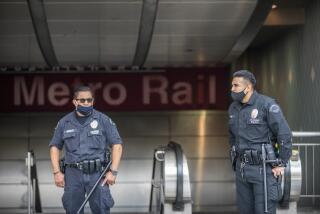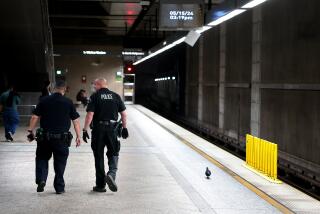Feasibility of MTA Breakup
- Share via
Re “Council OKs Bus Zone Study Amid Concerns,” Jan. 12.
Much discussion went on at the City Council recently on studying the feasibility of breaking up the Metropolitan Transportation Authority in support of a separate bus system for the San Fernando Valley. Improved service at a lower cost, goes their reasoning--and we think it’s poor reasoning.
The creation of separate transit “zones” to serve different sections of the city would serve riders less efficiently than the existing system, leading to decreases in ridership. Smaller is not necessarily better or even more effective. The existing transfer system allows riders to travel across town using existing MTA routes. Our experience has shown that both the cost and inconvenience would surely increase if riders had to use two or more separate bus systems.
The concerns of labor are valid. Let’s not be so shortsighted that we go after a new, and not necessarily better, system that would come at the expense of working people. Instead of focusing on the faces of MTA employees, many of whom know and care about their riders and go to extraordinary lengths to accommodate them, we should focus on the faces of the people who take the MTA. They consider it a lifeline to jobs, friends and home.
Public transportation was never intended to be a profit zone. It is a service to help everyday people get places they otherwise couldn’t. The MTA does this as no other system could.
CAROL WHEELER
Executive Director,
District Council 36,
American Federation of State, County and Municipal Employees
Los Angeles
*
Re “User-Friendly Mass Transit,” Valley Edition editorial, Jan. 23.
While on hold at 1-800-COMMUTE waiting for route and schedule information, I learn that the MTA plans to purchase 2,997 new buses this year. This is a golden opportunity to improve the signage on the front of the buses to make the number and destination more distinct.
Surely I’m not the only traveler who finds it virtually impossible to read the information until the bus reaches the stop. The solar glare at sunrise and sunset worsens the problem.
I’m sure visually compromised persons, seniors and probably the majority of riders would welcome this seemingly simple solution to one of their travel woes.
Examples of cities with easy to read bus signs--I’ve visited--are Boston, Philadelphia, Santa Monica and London.
ANNE LIPMAN
Tarzana
More to Read
Sign up for Essential California
The most important California stories and recommendations in your inbox every morning.
You may occasionally receive promotional content from the Los Angeles Times.












